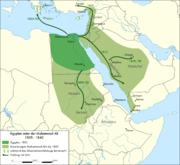| Oriental Crisis of 1840 | |||||||
|---|---|---|---|---|---|---|---|
| Part of Egyptian–Ottoman War (1839–1841) | |||||||
| |||||||
| Belligerents | |||||||
|
|
| ||||||
| Commanders and leaders | |||||||
The Oriental Crisis of 1840 was the result of a political conflict in the eastern Mediterranean between Egypt and the Ottoman Empire, in the middle of a war between the two. It was triggered by the nominal Ottoman governor-general of Egypt (but de facto independent and self-declared monarch) Muhammad Ali Pasha's aims to establish a personal empire in the Ottoman province of Egypt.
Background[]
In the preceding decades, Muhammad Ali had expanded and strengthened his hold on Ottoman territory, beginning with Egypt where he acted as a viceroy for the Sultan. Called upon to assist the Ottomans in the Greek War of Independence, Muhammad Ali in return demanded parts of Ottoman Syria to be transferred to his personal rule. When the war ended and the Porte didn't live up to its promise, Muhammad Ali launched a military campaign against his Ottoman masters and easily took most of the Syrian lands.
Syrian War[]

Extent of Muhammad Ali's rule in 1840
In 1839, the Ottoman Empire attempted to retake Syria from Muhammad Ali but was defeated by his son, Ibrahim Pasha in the Battle of Nezib. Following this, a new war between Muhammad Ali and the Ottomans escalated, with the latter once again failing to wage it successfully. In June 1840, the entire Ottoman navy defected and the French planned to offer full support to Muhammad Ali's cause.[1] On the verge of total collapse and defeat to Muhammad Ali, an alliance of European powers comprising the Britain, the Austrian Empire, Prussia and Russia decided to intervene on behalf of the young Sultan Abdülmecid I.
Convention of London[]
By the Convention of London, signed on 15 July 1840, these Great Powers offered Muhammad Ali and his heirs permanent control over Egypt (and Sudan) and the Eyalet of Acre, provided that these territories would nominally remain part of the Ottoman Empire. If he did not accept withdrawal of his forces within ten days he should lose the offer in southern Syrian; if he delayed acceptance more than 20 days, he should forfeit everything offered.[2] The European powers agreed to use all possible means of persuasion to effect the agreement, but Muhammad Ali hesitated, believing in support from the Kingdom of France.[3]
French position[]
The French under the newly formed cabinet of Prime Minister Adolphe Thiers sought to increase French influence in North Africa following their conquest of Algeria. For this, supporting Muhammad Ali's so far successful revolt seemed suitable. Counter Admiral Julien Pierre Anne Lalande was dispatched to the Mediterrenean to eventually join forces with the defected Ottoman fleet.[4] But France became politically isolated when the other Great Powers backed up the Sultan, and Thiers wasn't prepared to bring the country into open war with Britain. France switched sides and aligned against Muhammad Ali in October 1840.
Military campaign[]

HMS Phoenix in the bombardment of Acre, 1840
In September 1840, the European powers eventually moved from diplomatic means to military action. When French support for Muhammad Ali failed to materialize, British and Austrian naval forces in the eastern Mediterranean moved against Syria and Alexandria.[5]
Alexandria was the port where the defecting Ottoman fleet had withdrawn. After the Royal Navy and the Austrian Navy first blockaded the Nile delta coastline, they moved east to shell Sidon and Beirut on 11 September 1840. British and Austrian forces then attacked Acre. Following the bombardment of the city and the port on 3 November 1840 a small landing party of Austrian, British and Ottoman troops (which were led personally by the Austrian fleet commander, Archduke Friedrich) took the citadel after Muhammad Ali's Egyptian garrison in Acre had fled.
Long term results[]
After the surrender of Acre, Muhammad Ali finally accepted the terms of the Convention on 27 November 1840. He renounced his claims over Crete and the Hijaz and agreed to downsize his naval forces and his standing army to 18,000 men, provided that he and his descendants would enjoy hereditary rule over Egypt and Sudan — an unheard-of status for an Ottoman viceroy.[6] The firmans, subsequently issued by the sultan, indeed confirmed Muhammad Ali's rule over Egypt and the Sudan. He withdrew from Syria, Crete and handed back the Ottoman fleet.
See also[]
- History of Ottoman Egypt
- History of the Ottoman Empire
- History of Egypt under the Muhammad Ali dynasty
References[]
- ↑ Efraim Karsh, Inari Karsh, Empires of the Sand: The Struggle for Mastery in the Middle East, 1789-1923, (Harvard University Press, 2001), 36-37.
- ↑ Geoffrey G. Butler, Simon Maccoby, The Development of International Law, p. 440
- ↑ Efraim Karsh, Inari Karsh, Empires of the Sand: The Struggle for Mastery in the Middle East, 1789-1923, (Harvard University Press, 2001), 38.
- ↑ Efraim Karsh, Inari Karsh, Empires of the Sand: The Struggle for Mastery in the Middle East, 1789-1923, (Harvard University Press, 2001), 37.
- ↑ H. Wood Jarvis, Pharaoh to Farouk, (London: John Murray, 1956), 134.
- ↑ Morroe Berger, Military Elite and Social Change: Egypt Since Napoleon, (Princeton, New Jersey: Center for International Studies, 1960), 11.
Further reading[]
- Charles R. Middleton. Cabinet Decision Making at the Accession of Queen Victoria: The Crisis of the East 1839-1840," Journal of Modern History (1979) 51#2 On Demand Supplement pp. D1085-D1117 in JSTOR
The original article can be found at Oriental Crisis of 1840 and the edit history here.